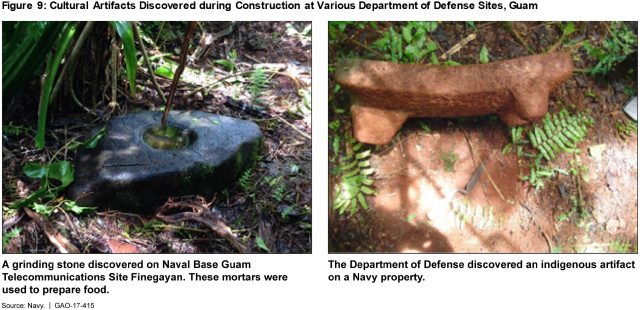The Evolving U.S. Military Presence on Guam
 (Excerpted from GAO-14-82)
(Excerpted from GAO-14-82)
- Construction labor shortage: DOD needs 2,800 foreign laborers to help with construction, and Guam relies on the H-2B visa program to fill these positions. However, approval rates for these visas decreased in 2016. Military and government of Guam officials told us that construction contractors have had trouble getting approvals for these visas to fill skilled labor positions.
- Explosive-ordnance detection: Whenever construction occurs on Guam, DOD must first look for potential explosive ordnance buried underground from prior conflicts. When contractors scan for ordnance, they have to check out everything that sets off the detectors—including tin cans and scrap metal. This can significantly delay construction projects. For example, the Navy experienced a $4.9-million cost increase and a 10-month delay for a utilities project because the contractor found more of this non-ordnance material than predicted in the initial contract.
 (Excerpted from GAO-17-415)
(Excerpted from GAO-17-415)
- Cultural-artifact discovery and preservation: Digging up the island can unearth pieces of its history and these cultural artifacts must be preserved. Although there have been efforts to streamline the discovery and preservation process, it can be lengthy. For example, one construction project could require DOD to preserve artifacts on 21 historically significant sites—which may result in additional costs and delays. Yet DOD has not fully planned for such delays.
 (Excerpted from GAO-17-415)
(Excerpted from GAO-17-415)
- Endangered-species protection: Guam is also home to endangered species. To help ensure construction doesn’t disturb them, the U.S. Fish and Wildlife Service develops protection plans. However, these plans take time to produce. For example, there were delays after discovering endangered orchid and butterfly species on the sites of two DOD construction projects. But again, DOD did not fully consider such delays in its planning.
- Questions on the content of this post? Contact Brian Lepore at leporeb@gao.gov.
- Comments on GAO’s WatchBlog? Contact blog@gao.gov.

GAO's mission is to provide Congress with fact-based, nonpartisan information that can help improve federal government performance and ensure accountability for the benefit of the American people. GAO launched its WatchBlog in January, 2014, as part of its continuing effort to reach its audiences—Congress and the American people—where they are currently looking for information.
The blog format allows GAO to provide a little more context about its work than it can offer on its other social media platforms. Posts will tie GAO work to current events and the news; show how GAO’s work is affecting agencies or legislation; highlight reports, testimonies, and issue areas where GAO does work; and provide information about GAO itself, among other things.
Please send any feedback on GAO's WatchBlog to blog@gao.gov.
